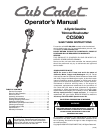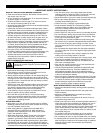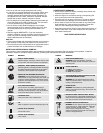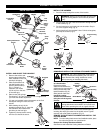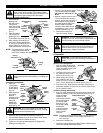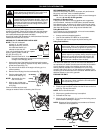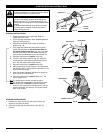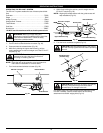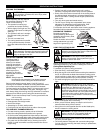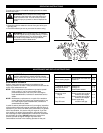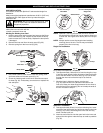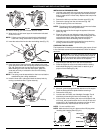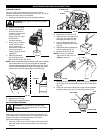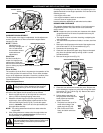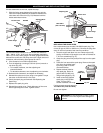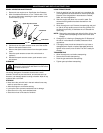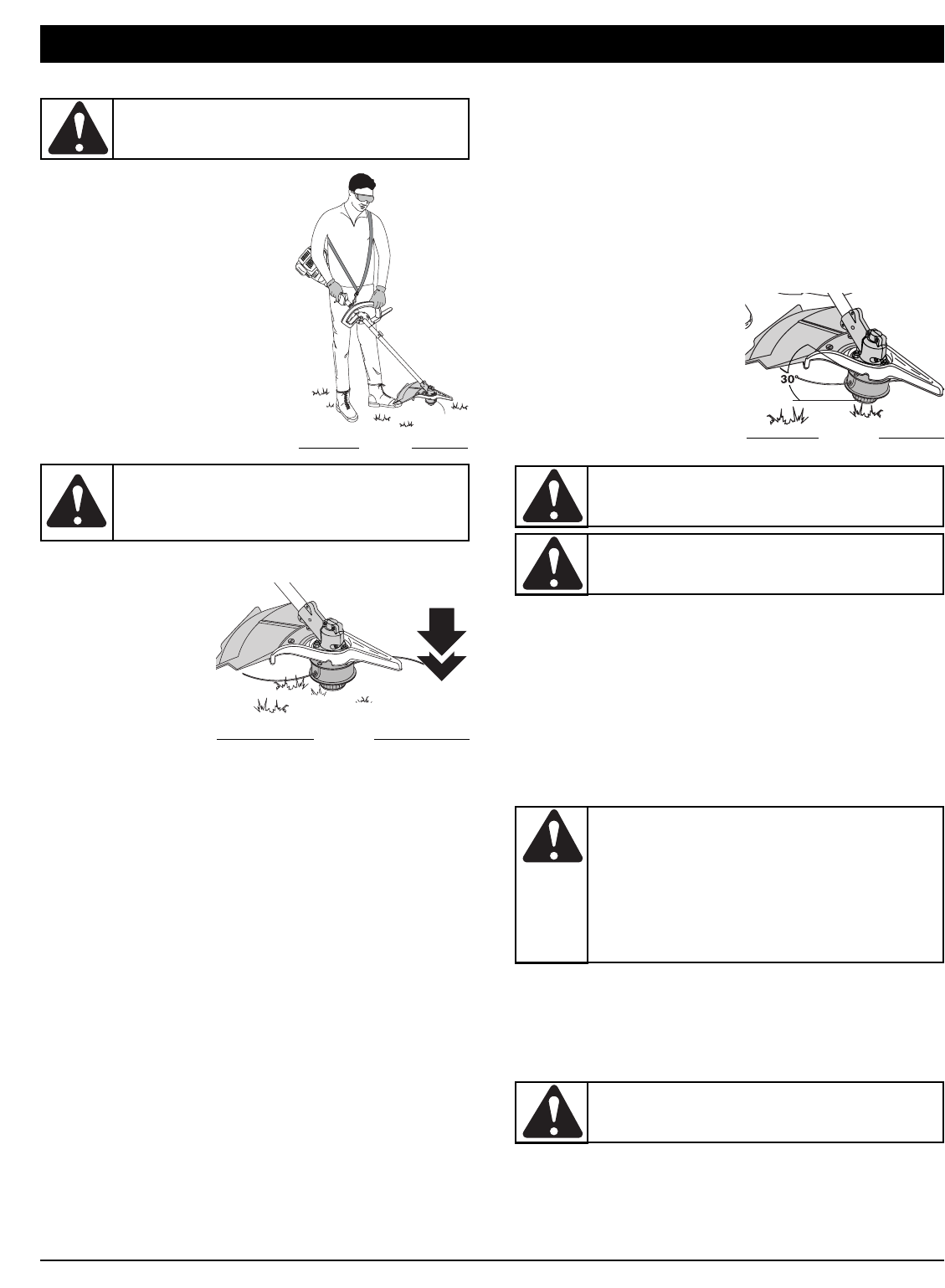
9
HOLDING THE TRIMMER
Before operating the unit, stand in
the operating position (Fig. 25).
Check for the following:
• The operator is wearing eye
protection and proper clothing
• With a slightly-bent right arm, the
operator’s right hand is holding the
shaft grip
• The operator’s left arm is straight,
the left hand holding the assist
handle
• The unit is at waist level
• The cutting attachment is parallel
to the ground and easily contacts
the grass without the need to bend
over
ADJUSTING TRIMMING LINE LENGTH
The Bump Head™
cutting attachment
allows you to release
trimming line without
stopping the engine. To
release more line, lightly
tap the cutting
attachment on the
ground (Fig. 26) while
operating the trimmer at
high speed.
NOTE: Always keep the
trimming line fully extended. Line release becomes
more difficult as the cutting line becomes shorter.
Each time the head is bumped, about 1 inch (25.4 mm) of
trimming line is released. A blade in the cutting attachment shield
will cut the line to the proper length if excess line is released.
For best results, tap the Bump Head™ on bare ground or hard
soil. If line release is attempted in tall grass, the engine may
stall. Always keep the trimming line fully extended. Line release
becomes more difficult as the cutting line becomes shorter.
NOTE: Do not rest the Bump Head™ on the ground while the
unit is running.
Some line breakage will occur from:
• Entanglement with foreign matter
• Normal line fatigue
• Attempting to cut thick, stalky weeds
• Forcing the line into objects such as walls or fence posts
TIPS FOR BEST TRIMMING RESULTS
• For best trimming results, operate unit at full throttle.
• Keep the cutting attachment parallel to the ground.
• Do not force the cutting attachment. Allow the tip of the line to
do the cutting, especially along walls. Cutting with more than the
tip will reduce cutting efficiency and may overload the engine.
• Cut grass over 8 inches (200 mm) by working from top to
bottom in small increments to avoid premature line wear or
engine drag.
• Cutting from left to right improves the unit's cutting
efficiency. Clippings are thrown away from the operator.
• Slowly move the trimmer into and out of the cutting area at
the desired height. Move either in a forward-backward or
side-to-side motion. Cutting shorter lengths produces the
best results.
• Trim only when grass and weeds are dry.
• The life of your cutting line is dependent upon proper
adherence of explained trimming techniques, what
vegetation is cut, and where vegetation is cut.
For example, the line will wear faster when trimming against a
foundation wall as opposed to trimming around a tree.
DECORATIVE TRIMMING
Decorative trimming is
accomplished by removing all
vegetation around trees, posts,
fences and more.
Rotate the whole unit so that the
cutting attachment is at a 30°
angle to the ground (Fig. 27).
USING THE CUTTING BLADE
Before operating the unit with the cutting blade, stand in the
operating position (Fig. 28). Refer to Holding the Trimmer.
Cutting Blade Operating Tips
To establish a rhythmic cutting procedure:
• Plant feet firmly, comfortably apart.
• Bring the engine to full throttle before entering the material to
be cut. At full throttle the blade has maximum cutting power
and is less likely to bind, stall or cause blade thrust (which can
result in serious personal injury to the operator or others).
• Cut while swinging the upper part of your body from left to
right.
• Always release the throttle trigger and allow the engine to
return to idle speed when not cutting.
• When you are finished, always unsnap the unit from the
harness before taking off the harness.
• Swing the unit in the opposite direction as the blade spins,
which increases the cutting action.
• After the return swing, move forward to the next area to be
cut plant your feet again.
• The cutting blade is designed with a second cutting edge.
You can use it by removing the blade, turning it upside down,
and reinstalling it.
OPERATING INSTRUCTIONS
WARNING: Do not remove or alter the line cutting
blade assembly. Excessive line length will make the
clutch overheat. This may lead to serious personal
injury or damage to the unit.
WARNING: Always wear eye, hearing, foot and
body protection to reduce the risk of injury when
operating this unit.
Fig. 25
Fig. 27
Fig. 26
WARNING: Always wear eye, hearing, foot, body
protection and the shoulder strap to reduce the risk
of injury when operating this unit.
WARNING: Do not use the cutting blade for
edging or as an edger. Severe personal injury to
yourself or others can result.
WARNING: Blade thrust may occur when the
spinning blade contacts an object that it does not
immediately cut. Blade thrust can be violent
enough to cause the unit and/or operator to be
propelled in any direction, and possibly lose control
of the unit. Blade thrust can occur without warning
if the blade snags, stalls or binds. This is more
likely to occur in areas where it is difficult to see the
material being cut.
WARNING: The blade continues to spin after the
engine is turned off. The coasting blade can
seriously cut you if accidentally touched.



